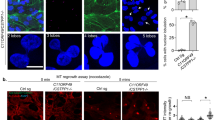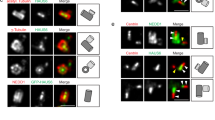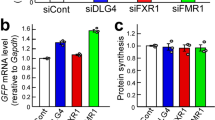Abstract
The gene MID1, the mutation of which causes X-linked Opitz G/BBB syndrome (OS, MIM 300000), encodes a microtubule-associated protein (MAP). We show that mutation of MID1 leads to a marked accumulation of the catalytic subunit of protein phosphatase 2A (PP2Ac), a central cellular regulator. PP2Ac accumulation is caused by an impairment of a newly identified E3 ubiquitin ligase activity of the MID1 protein that normally targets PP2Ac for degradation through binding to its α4 regulatory subunit in an embryonic fibroblast line derived from a fetus with OS. Elevated PP2Ac causes hypophosphorylation of MAPs, a pathological mechanism that is consistent with the OS phenotype.
This is a preview of subscription content, access via your institution
Access options
Subscribe to this journal
Receive 12 print issues and online access
$209.00 per year
only $17.42 per issue
Buy this article
- Purchase on Springer Link
- Instant access to full article PDF
Prices may be subject to local taxes which are calculated during checkout







Similar content being viewed by others
References
Robin, H.N., Opitz, J.M. & Muenke, M. Opitz G/BBB syndrome: clinical comparisons of families linked to Xp22 and 22q, a review of the literature. Am. J. Med. Genet. 62, 305–317 (1996).
Robin, H.N. et al. Opitz syndrome is genetically heterogenous, with one locus on Xp22, and a second locus on 22q11.2. Nature Genet. 11, 459–461 (1995).
Quaderi, N.A. et al. Opitz G/BBB syndrome, a defect of midline development, is due to mutations in a new RING finger gene on Xp22. Nature Genet. 17, 285–291 (1997).
Schweiger, S. et al. The Opitz syndrome gene product, MID1, associates with microtubules. Proc. Natl Acad. Sci. USA 96, 2794–2799 (1999).
Wu, L.C. et al. Identification of a RING protein that can interact in vivo with the BRCA1 gene product. Nature Genet. 14, 430–440 (1996).
Borden, K.L.B., Lally, J.M., Martin, S.R., O'Reilly, N.J., Solomon, E. & Freemont, P.S. In vivo and in vitro characterization of the B1 and B2 zinc-binding domains from the acute promyelocytic leukemia protooncoprotein PML. Proc. Natl Acad. Sci. USA 93, 1601–1606 (1996).
Dyck, J.A. et al. A novel macromolecular structure is a target of the promyelocyte–retinoic acid receptor oncoprotein. Cell 76, 333–243 (1994).
Fang, S., Jensen, J.P., Ludwig, R.L., Vousden, K.H. & Weissman, A.M. Mdm2 is a RING finger–dependent ubiquitin protein ligase for itself and p53. J. Biol. Chem. 275, 8945–8951 (2000).
Fang, D., et al. Cbl-b, a RING-type E3 ubiquitin ligase, targets phosphatidylinositol 3-kinase for ubiquitination in T cells. J. Biol. Chem. 276, 4872–4878 (2001).
Shimura, H. et al. Ubiquitination of a new form of α-synuclein by parkin from human brain: implications for Parkinson's disease. Science 293, 263–269 (2001).
Tyers, M. & Jorgensen, P. Proteolysis and the cell cycle: with this RING I do thee destroy. Curr. Opin. Genet. Dev. 10, 54–64 (2000).
Murata, K., Wu, J. & Brautigan, D.L. B cell receptor–associated protein α4 displays rapamycin sensitive binding directly to the catalytic subunit of protein phosphatase 2A. Proc. Natl Acad. Sci. 94, 10624–10629 (1997).
Price, N.E., Wadzinski, B. & Mumby, M.C. An anchoring factor targets protein phosphatase 2A to brain microtubules. Mol. Brain Res. 73, 68–77 (1999).
Dick, L.R. et al. Mechanistic studies on the inactivation of the proteasome by lactacystin. J. Biol. Chem. 271, 7273–7276 (1996).
Chen, J., Peterson, R.T. & Schreiber, S.L. α4 associates with protein phosphatase 2A, 4, and 6. Biochem. Biophys. Res. Commun. 247, 827–832 (1998).
Inui, S. et al. Molecular cloning of a cDNA clone encoding a phosphoprotein component related to the Ig receptor–mediated signal transduction. J. Immunol. 154, 2714–2723 (1995).
Buchner, G. et al. MID2, a homologue of the Opitz syndrome gene MID1: similarities in subcellular localization and differences in expression during development. Hum. Mol. Genet. 8, 1397–1407 (1999).
Reymond, A. et al. The tripartite motif family identifies cell compartments. EMBO J. 20, 2140–2151 (2001).
Moynihan, T.P. et al. The ubiquitin-conjugating enzymes UbcH7 and UbcH8 interact with RING finger/IBR motif–containing domains of HHARI and H7-AP1. J. Biol. Chem. 274, 30963–30968 (1999).
Cainarca, S., Messali, S., Ballabio, A. & Meroni, G. Functional characterization of the Opitz syndrome gene product (midin): evidence for homodimerization and association with microtubules throughout the cell cycle. Hum. Mol. Genet. 8, 1387–1396 (1999).
Sontag, E., Nunbhakdi-Craig, V., Bloom, G.S. & Mumby, M.C. A novel pool of protein phosphatase 2A is associated with microtubules and is regulated during the cell cycle. J. Cell Biol. 128, 1131–1144 (1995).
Baharians, Z. & Schönthal, A.H. Autoregulation of protein phosphatase type 2A expression. J. Biol. Chem. 273, 19019–19024 (1998).
Zolnierowsicz, S. Type 2A protein phosphatase, the complex regulator of numerous signaling pathways. Biochem. Pharmacol. 60, 1225–1235 (2000).
Wera, S. & Hemmings, B.A. Serine/threonine protein phosphatases. Biochem. J. 311, 17–29 (1995).
Goldberg, Y. Protein phosphatase 2A: who shall regulate the regulator? Biochem. Pharmacol. 57, 321–328 (1999).
Trojanowski, J.Q. & Lee, V.M.Y. Phosphorylation of paired helical filament tau in Alzheimer's disease neurofibrillary lesions: focusing on phosphatases. FASEB J. 9, 1570–1576 (1995).
Baharians, Z. & Schönthal, A.H. Reduction of Ha-ras-induced cellular transformation by elevated expression of protein phosphatase type 2A. Mol. Carcinogenesis 24, 246–254 (1999).
Kawabe, T., Muslin, A.J. & Korsmeyer, S.J. HOX11 interacts with protein phosphatases PP2A and PP1 and disrupts a G2/M cell-cycle checkpoint. Nature 385, 454–458 (1997).
Hsu, W., Zeng, L. & Constantini, F. Identification of a domain of axin that binds to the serine/threonine protein phosphatase 2A and a self-binding domain. J. Biol. Chem. 274, 3439–3445 (1999).
Uemura, T., Shiomi, K., Togashi, S. & Takeichi, M. Mutation of twins encoding a regulator of protein phosphatase 2A leads to pattern duplication in Drosophila imaginal disks. Genes. Dev. 7, 429–440 (1993).
Deng, X., Takahiko, I., Carr., B., Mumby, W. & May, W.S. Reversible phosphorylation of bcl2 following interleukin 3 or bryostatin 1 is mediated by direct interaction with protein phosphatase 2A. J. Biol. Chem. 273, 34157–34163 (1998).
Santoro, M.F. et al. Regulation of protein phosphatase 2A activity by caspase-3 during apoptosis. J. Biol. Chem. 273, 13119–13128 (1998).
Maier, G.D. et al. Regulation of cytoskeletal organization in tumor cells by protein phosphatase-1 and -2A. Int. J. Cancer 61, 54–61 (1995).
Ito, A. et al. Truncated isoform of the PP2A B56 subunit promotes cell motility through paxillin phosphorylation. EMBO J. 19, 562–571 (2000).
Kobayashi, N. et al. Process formation of podocytes: morphogenetic activity of microtubules and regulation by protein serine/threonine phosphatase PP2A. Histochem. Cell Biol. 115, 255–266 (2001).
Gong, C. et al. Regulation of phosphorylation of neuronal microtubule-associated proteins MAP1b and MAP2 by protein phosphatase-2A and -2B in rat brain. Brain Res. 853, 299–309 (2000).
Avila, J., Dominguez, J. & Diaz, N.J. Regulation of microtubule dynamics by microtubule-associated protein expression and phosphorylation during neuronal development. Int. J. Dev. Biol. 38, 13–25 (1994).
Sapir, T., Cahana, A., Seger, R., Nekhai, S. & Reiner, O. LIS1 is a microtubule-associated phosphoprotein. Eur. J. Biochem. 265, 181–188 (1999).
Liu, J., Prickett, T.D., Elliott, E., Meroni, G. & Brautigan, D.L. Phosphorylation and microtubule association of the Opitz syndrome protein mid-1 is regulated by protein phosphatase 2A via binding to the regulatory subunit α4. Proc. Natl Acad. Sci. USA 98, 6650–6655 (2001).
Jackson, P.K. et al. The lore of the RINGs: substrate recognition and catalysis by ubiquitin ligases. Trends Cell Biol. 10, 429–439 (2000).
Freemont, P.S. RING for destruction? Curr. Biol. 10, R84–R87 (2000).
Joazeiro, C.A. & Weissman, A.M. RING finger proteins: mediators of ubiquitin ligase activity. Cell 102, 549–552 (2000).
Nanahoshi, M. et al. Regulation of protein phosphatase 2A catalytic activity by α4 protein and its yeast homologue Tap42. Biochem. Biophys. Res. Commun. 251, 520–526 (1998).
Briault, S. et al. A gene for FG syndrome maps in the Xq12–q21.31 region. Am. J. Med. Genet. 73, 87–90 (1997).
Graham, J.M. et al. Report of three new families with linkage to Xq12– q22.1. Am. J. Med. Genet. 80, 145–156 (1998).
Opitz, J.M. & Kaveggia, E.G. The FG syndrome: an X-linked recessive syndrome of multiple congenital anomalies and mental retardation. Z. Kinderheilk. 117, 1–18 (1974).
Fields, S. & Sternglanz, R. The two-hybrid system: an assay for protein-protein interactions. Trends Genet. 10, 286–292 (1994).
Klose, J. & Kobalz, U. Two-dimensional electrophoresis of proteins: an updated protocol and implications for a functional analysis of the genome. Electrophoresis 16, 1034–1059 (1995).
Acknowledgements
We thank H. Madle and S. Freier for tissue culturing, V. Kalscheuer and B. Auer for their continuous support and helpful discussions, F. Fresser and G. Baier for their excellent support concerning the yeast two-hybrid methodology, K. Wrogemann for the correction of the manuscript and F. Erdogan for computer support. This work was supported by the Austrian National Bank Project 7961 (to R.S.) and by the Deutsche Forschungsgemeinschaft (DFG) Grant RO389/17-3 (to H.H.R.). This article is dedicated to M. Schweiger on the occasion of his 65th birthday.
Author information
Authors and Affiliations
Corresponding author
Rights and permissions
About this article
Cite this article
Trockenbacher, A., Suckow, V., Foerster, J. et al. MID1, mutated in Opitz syndrome, encodes an ubiquitin ligase that targets phosphatase 2A for degradation. Nat Genet 29, 287–294 (2001). https://doi.org/10.1038/ng762
Received:
Accepted:
Published:
Issue Date:
DOI: https://doi.org/10.1038/ng762
This article is cited by
-
Opitz syndrome: improving clinical interpretation of intronic variants in MID1 gene
Pediatric Research (2023)
-
GqPCR-stimulated dephosphorylation of AKT is induced by an IGBP1-mediated PP2A switch
Cell Communication and Signaling (2022)
-
Ubiquitin ligases: guardians of mammalian development
Nature Reviews Molecular Cell Biology (2022)
-
Mid1 is associated with androgen-dependent axonal vulnerability of motor neurons in spinal and bulbar muscular atrophy
Cell Death & Disease (2022)
-
Differential accumulation of tau pathology between reciprocal F1 hybrids of rTg4510 mice
Scientific Reports (2021)



